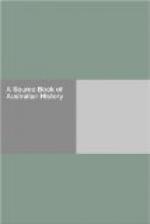A large flock of gannets was observed at daylight, to issue out of the Great Bight to the southward; and they were followed by such a number of the sooty petrels as we had never seen equalled. There was a stream of from fifty to eighty yards in depth, and of three hundred yards or more in breadth; the birds were not scattered, but flying as compactly as a free movement of their wings seemed to allow; and during a full hour and a half, this stream of petrels continued to pass without interruption, at a rate little inferior to the swiftness of the pigeon. On the lowest computation, I think the number could not have been less than a hundred millions; and we were thence led to believe that there must be, in the large bight, one or more uninhabited islands of considerable size.
From the north-east point of the three-hummock land, the shore trended W. 1 deg. N. three miles; then S. 39 deg. W. four miles, to a rocky point forming the south-west extremity of what was then ascertained to be Three-hummock Island. The channel which separates it from the land to the west is, at least, two miles in width, and is deep; so that it was difficult to conjecture how the Indians were able to get over to the island. It was almost certain that they had no canoes at Port Dalrymple, nor any means of reaching islands lying not more than two cable lengths from the shore; and it therefore seemed improbable that they should possess canoes here. The small size of Three-hummock Island rendered the idea of fixed inhabitants inadmissible; and whichever way it was considered, the presence of men there was a problem difficult to be resolved.
The coast on the west side of the channel lies nearly south, and rises in height as it advances towards the cliffy head, set on the 6th p.m. The north end of this island is a sloping rocky point; and the first projection which opened round it, was at S. 32’ W., five or six miles. Beyond this there was nothing like mainland to be seen; indeed, this western land itself had very little the appearance of being such, either in its form, or in its poor starved vegetation. So soon as we had passed the north sloping point, a long swell was perceived to come from the South-west, such as we had not been accustomed to for some time. It broke heavily upon a small reef, lying a mile and a half from the point, and upon all the western shores; but although it was likely to prove troublesome, and perhaps dangerous, Mr. Bass and myself hailed it with joy and mutual congratulation, as announcing the completion of our long-wished-for discovery of a passage into the Southern Indian Ocean.
We had a fine breeze at east; and our course was directed for a small, rocky island, which lies W. 1/2 N. 6 miles from the north point of the barren land. This land appeared to be almost white with birds; and so much excited our curiosity and hope of procuring a supply of food, that Mr. Bass went on shore in the boat whilst I stood off and on, waiting his return. No land could be seen to the northward, and the furthest clearly distinguishable in the opposite direction was a steep island at the distance of four leagues.




